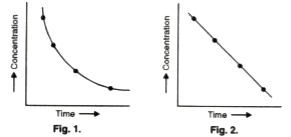In the reaction A+B→C+D, the rate (dxdt) when plotted against time 't' gives a straight line parallel to time aixs.
The order and rate of reaction will be:
1,k+1
0,k
(1 k),1
k,k 1
The correct Answer is:B
For a zero order reaction, rate of the reaction remains constant with time.
Topper's Solved these Questions
- CHEMICAL KINETICS BOOK - VMC MODULES ENGLISHCHAPTER - CHEMICAL KINETICS EXERCISE - Level-2 ( Numerical Value Type for JEE Main )
15 Videos
- CHEMICAL KINETICS BOOK - VMC MODULES ENGLISHCHAPTER - CHEMICAL KINETICS EXERCISE - JEE Main (Archive)
56 Videos
- CHEMICAL KINETICS BOOK - VMC MODULES ENGLISHCHAPTER - CHEMICAL KINETICS EXERCISE - Level-1
75 Videos
- CHEMICAL EQUILIBRIUMBOOK - VMC MODULES ENGLISHCHAPTER - CHEMICAL EQUILIBRIUMEXERCISE - IN-CHAPTER EXERCISE - G
10 Videos
- CHEMICAL THERMODYNAMICS BOOK - VMC MODULES ENGLISHCHAPTER - CHEMICAL THERMODYNAMICS EXERCISE - IN - CHAPTER EXERCISE - L
10 Videos
Similar Questions
Knowledge Check
A plot of log (a-x) against time 't' is a straight line. This indicates that the reaction is of :
Azero orderBfirst orderCsecond orderDthird order
In the reaction A→ B , if the concentration of A is plotted against time, the curves obtained will be as shown in Fig. 1 and 2. Predict the order of the reactions.

View SolutionIn the reaction A→ B , if the concentration of A is plotted against time, the curves obtained will be as shown in Fig. 1 and 2. Predict the order of the reactions.

View SolutionGive the order of reaction rate with alc-KOH

View SolutionThe order of reaction is an experimentally determined quanity. It may be zero, poistive, negative, or fractional. The kinetic equation of nth order reaction is
k×t=1(n−1)[1(a−x)n−1−1an−1] …(i)
Half life of nth order reaction depends on the initial concentration according to the following relation:
t1/2∝1an−1 ...(ii)
The unit of the rate constant varies with the order but general relation for the unit of nth order reaction is
Units of k=[1Conc]n−1×Time−1 ...(iii)
The differential rate law for nth order reaction may be given as:
dxdt=k[A]n ...(iv)
where A denotes the reactant.
In a chemical reaction A→B, it is found that the rate of the reaction doubles when the concentration of A is increased four times. The order of the reaction with respect to A is:
View SolutionFor the reaction 2A+B→C, the values of initial rate at different reactant concentrations are given in the table below. The over all order of reaction is __________.

View SolutionFor a reaction A→B , the rate of reaction becomes twenty seven times when the concentration of A is increased three times. What is the order of the reaction?
View SolutionFor a reaction A→B , the rate of reaction becomes twenty seven times when the concentration of A is increased three times. What is the order of the reaction?
View Solution
